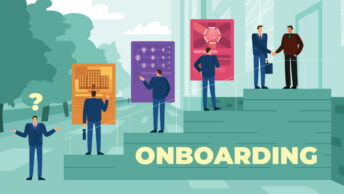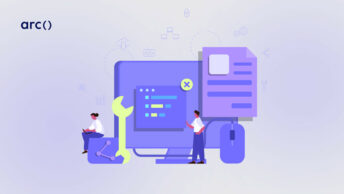With technology changing so fast, software developers have to make every effort to stay ahead of the curve.
Running a software house, the goal is to deliver outstanding, innovative web and mobile experiences. For Apptension, a key part of achieving those objectives has been investing in employee development, explained Zbigniew Czarnecki, the company’s CEO.
Czarnecki makes it a point to provide front-end developers with multiple opportunities for professional development, arguing that this improves the quality of work they deliver, ultimately benefiting the company and its customers.
Looking for top talent fast? See how Arc can help you:
⚡️ Find developers, designers, marketers, and more
⚡️ Freelance or full-time remote + fully vetted
⚡️ Save up to 80% with global hires
Hire top talent with Arc risk-free →
Why Focus on Employee Development?
At the end of the day, as a company executive, you want to see a return on your investment, right?
“Employee development pays off over time” – says Czarnecki. “As employees become more skilled, the quality of their work increases, which benefits the projects they work on – and finally – the company’s revenue.”
“When it comes to our annual budget for employee training and conferences, we’ve spent $13,000 USD in 2016 and $21,000 in 2017. At the same time, our ARR grew by 31%, reaching $1,852,447 USD last year.”
Czarnecki sees a correlation between this revenue growth and investing in employee development, saying, “Since we’ve decided to focus on mentoring and training opportunities for our employees, we’ve seen an increase in the quality of the projects we complete. This has resulted in more long-term collaborations and returning clients who value our technical competences.”
Focusing on professional development impacts the developers and their career development as well. “The majority of our senior front-end developers have been working with us since they were junior or regular programmers, developing their skills and experience at Apptension. Again, we attribute it partially to our employee development strategy.”
Read More: How to Objectively Measure Software Developer Productivity
Approaches to Continuing Ed and Employee Development
“If you want to focus on employee development, make sure that your efforts align with your company’s culture” – suggests Czarnecki.
This means implementing ideas that support the core values of their company: exchanging knowledge between employees, ensuring their constant development, and team building.
To align employee development with these values, Apptension has a mentoring program, attends conferences and events, and makes time for developers to attend hackathons and complete side projects.
The sections below explain how they go about it.
Mentoring Program
To make constant learning and knowledge sharing easier, front-end developers are divided into groups of 3-4 people. Groups work together on small projects involving a chosen tech like React Native or Firebase.
Each group is supervised by a mentor (one of the senior devs). Then, once a month, their group projects are discussed during a meeting called DevTalk.
This approach, Czarnecki explains, “enhances front-end developers’ opportunity to learn from each other about the latest libraries, frameworks, or architectures.”
Conferences and Events
Speaking at conferences and attending events is another way of pushing the boundaries for your employees. Being a speaker is a chance to master one’s skills — and not just the ones related directly to software development.
“Thanks to that kind of experience, our front-end devs become better at public speaking — they foster their leadership skills and boost self-confidence, which are important for managing and leading their teams at work” – says Czarnecki.
When developers speak at industry events, employers should consider footing the bill to the greatest extent possible to encourage participation. For example, Apptension provides its employees with an annual conference and training budget that they can use as they see fit. This is in line with the company’s value of constant development.
Read More: How Founders Can Approach the Product Management Role (Kevin Lee)
Side Projects
Side projects allow developers to try out new tech and take a break from their regular assignments.
Eventually, what was once considered a side project, may turn into a product of its own.
“That’s exactly how teamdeck was built, our own SaaS tool for resource management. We started developing it internally due to the lack of a suitable tool for managing our employees, their availability, working time, and holidays. Today there’s a whole team working on it full-time.”
Apptension also gives senior developers the opportunity to work together on R&D projects every two weeks, e.g. implementing smart office solutions. This is a great way to learn about cutting edge technologies and improves creative thinking, not to mention developing cool office hacks for everyone to enjoy.
Hackathons
Taking part in hackathons is another way to try out new tech and create new, exciting projects. Plus, there’s the spirit of competition. And let’s admit it – who doesn’t want to prove their skills and win a prize? This kind of competition helps teams to learn new things or bolster existing skills.
“We encourage our employees to take part in various hackathons. For example, when they wanted to participate in Koding’s virtual hack.summit in 2016, we said “yes” right away. We opened up our office for a weekend, bought food and drinks, and supported our devs for the entire event. At the end, our team won the first prize of 100k USD, defeating over 1,250 other projects.”
The idea of a coding contest was later implemented internally to educate front-end developers. During this hackathon, they became tech leaders of their own projects, making decisions regarding the scope and tech stack. “At the same time, we asked senior developers to be Product Owners of these projects. Finally, the projects were presented during our holiday party, and the winning team received a cash prize.”
Read More: How to Use Performance Management To Build Better Teams (Jack Altman)
Does Focusing on Employee Development Pay Off?
“Professional development is part of a company’s culture from the very beginning” – says Czarnecki. “It contributes not only to the employees’ success, but to the quality of our projects, too.”
Employee development strategy may also help with recruiting new talent, as it is seen as a benefit wanted by 87% of millennial workers.
Last, it fosters the bond between your organization and its employees – studies have shown 65% of organizations that invested in employee development saw less staff turnover. As a 5-year-old company, “the tenure of senior developers averages at about 3 years, which we consider relatively high” – adds Czarnecki.
As you can see, investing in employee development may pay off in many ways including contributing to professional development and satisfaction, healthy company culture, satisfied clients, and, eventually higher revenue.
How to Get Started on Employee Development
“Constant development is in our company’s DNA. From the beginning we’ve been looking for ways to promote knowledge sharing between our employees” – says Zbigniew Czarnecki.
If you want to replicate this approach at your company, here are a few things to think about first:
- How much of a developer’s time can you dedicate to that purpose?
- Does your company culture promote knowledge sharing?
- How much are you willing to invest in a conference and training budget?
Or maybe you’d like to convince your boss to start investing in employee training and courses?
To effectively pitch employee development to management, focus on the potential ROI of implementing it at your organization. Help management to imagine the improved solutions and efficiency that will be possible after training is complete. Lastly, you can cite examples of how other companies have successfully utilized employee development.
Here are some of the ways your company may benefit from employee development:
- Employees are more effective at regular assignments
- Employees acquire new skills and create growth in new ways — or enhance existing projects
- They keep up with industry trends and latest solutions
- Employees who attended training or courses can share the knowledge with their team
Have you implemented employee development at your company? Share your story with us in the comments!
You can also try Arc, your shortcut to the world’s best remote talent:
⚡️ Access 450,000 top developers, designers, and marketers
⚡️ Vetted and ready to interview
⚡️ Freelance or full-time








